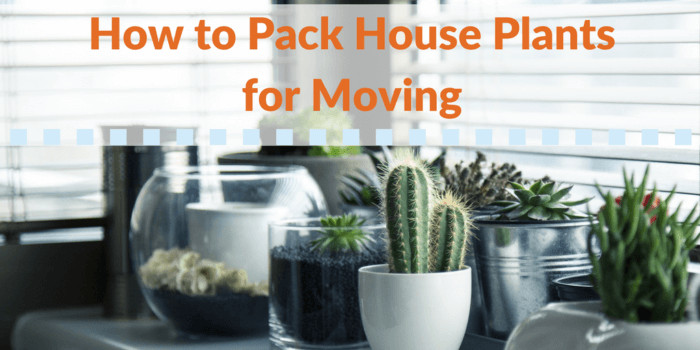How to Pack House Plants for Moving
February 3, 2017
Whether you’re a fool for a fern, have a green thumb, or are simply a run-of-the-mill Easter Lily enthusiast, chances are you have a couple of house plants.
House plants are wonderful. They’re known to increase mood, help stave off colds, and if my wife’s cats are any indication, they also serve as an excellent replacement for kitty chow. (Sidenote: lots of plants are deadly poisonous to cats, so please don’t go and feed your cats house plants instead of Meow Bites.)
There’s just one problem with house plants: if you’re me, they’re, like, super easy to kill accidentally.
Wait…
… Okay, so maybe there are two problems with house plants: if you’re me, their life span can be measured in hours, AND house plants are pretty difficult to pack and move.
First, a couple of important pointers about moving house plants:
1 If you’re moving to a new state, especially California, Arizona, Florida, or Oregon, double- and triple-check your new state’s regulations. Shockingly, some states have hard-boiled regulations on the types of flora that you can bring in with you, and many common house plants are on the “no” list. And if you’re thinking about shirking the law because who will know, anyway?, be aware that most of these states (California in particular) will stop a moving truck and check for plants at the border.
2 Most moving companies, whether they’re local movers or nationwide moving companies, won’t move your house plants, period. Some will, but won’t cover any damage that might happen during packing, loading, transit, or unloading. We at SML fall into the second category – we advise you to carry them with you in your personal vehicle(s), but if it absolutely has to be on the moving truck, we can still help you out.
3 The Gypsy Moth, which feeds voraciously on foliage, is an increasing problem in the United States. We recommend that you proatively treat all of your house plants against the Gypsy Moth before move to help prevent their spread.
Supplies you’ll need to pack your plants:
- Heavy 10lb. Packing Paper or Newsprint
- PLASTIC (not ceramic) Planting Pots
- One for every house plant, of the same size as the existing pot
- Stretch Wrap
- Sturdy Moving Boxes
Next, prepare your plants for the move:
Three Weeks Before your Move
Repot all of your plants into plastic pots of the same size as the original pot using sterilized potting soil (you can get this at any home improvement store or garden center).
One Week Before your Move
Prune all of your plants. This helps keep the plant healthy while it endures the stress of the move.
Day of your Move (or the Night Before)
1 Wrap large plants gently with an old bedsheet or with packing paper or newspaper. This helps protect fragile branches from snapping during the move.
2 For taller plants, pack the pot with sphagnum moss and then wrap the pot with stretch wrap. This will allow you to transport the plant on its side without spilling potting soil everywhere.
3 Place smaller plants inside a regular moving box, and fill the empty spaces between the pots (up to the rim of the pot) with “dunnage” – crumpled packing paper or newsprint, foam, or bubble wrap.
4 Cut air holes in the box and (if you must) tape the top of the box closed loosly. Even over a time period as short as an hour, insufficient oxygen can greatly harm your plants.

Sorry, I couldn’t resist.
5 Plants are very susceptible to temperature changes. If at all possible, keep them in a climate controlled environment the entire time (the A/C in your car is perfect for this). On longer moves, don’t leave your plants in your vehicle overnight – bring them into your hotel, motel, hostle, or shanty with you. This is one of the many reasons that it’s a terrible idea to move your house plants in a moving truck.
6 When you arrive at your new home, bring your plants inside first, before doing anything else. Your plants have endured quite a bit of stress (you probably have too!), so grab some water for the both of you.
What to do if your plants aren’t doing too well after your move:
We’ve assembled a list of symptoms and cures for the ten most common house plants.
| Species | Symptom | Likely Cause | Cure |
| African Violet | Spots on leaves | Water getting on leaves | Prune spotted leaves; water plant from the bottom |
| No flower buds | Not enough light | Move to a brighter spot; consider fertilizing | |
| Aloe Vera | Leaves fall over | Plant is too large | Divide plant into two pots |
| Leaves wither | Air is too dry | Water more often | |
| Boston Fern | Spindly fronds | Pot is too large | Fertilize or relocate to smaller pot (or both) |
| Brown fronds | Air is too dry | Use a cool mist humidifer | |
| Dieffenbachia | Brown leaves | Air is to hot/dry | Use a cool mist humidifier |
| Lanky leaves | Not enough light | Move to a spot with more sunlight | |
| Dracaena | Leaves droop | Too much sun | Move to a spot with less light |
| Ficus | Leaf drop | Too wet or too cold | Stop overwatering and/or move to a brighter, warmer place |
| Parlor Palm | Brown leaf tips | Dry air/soil | Water more often; consider a humidifier |
| Philodendron | Leaves droop | Too hot and dry | Soak thoroughly and move to a cooler spot |
| Leaves turn yellow | Too wet | Stop overwatering your poor Philodendron! | |
| Schefflera | Blackened leaf tips | Soggy soil | Stop overwatering |
| Leaf drop | Air is too cold | Move to a warmer/less drafty spot | |
| Spider Plant | Brown scorch marks | Leaf shine damage | Clean with sterilized water |
| Rotting in center | Too wet | Stop overwatering | |
| Brown leaf tips | Too hot/too dry | Move away from direct sunlight; water more often |











We Aim For 5 Star Service